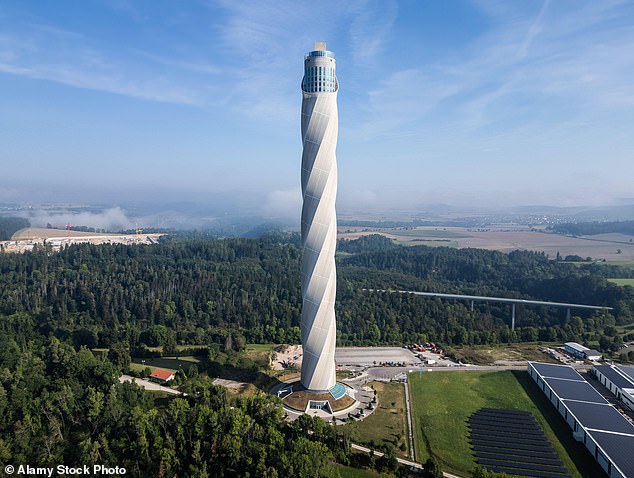On the outskirts of the medieval town of Rottweil in southeast Germany and surrounded by the Black Forest, an 800 ft skyscraper rules the land.
Considered to be one of the tallest buildings in the country, the TK Elevator Testturm was not built to house people, nor to to be filled with rows of office desks, but rather it was created to test the latest elevator models.
Built in 2017 by engineering firm TK Elevator, the tower is home to 12 shafts where next-generation lifts are being tested.
It is currently trialling TK Elevator’s MULTI system, which uses magnetic levitation, or maglev, to pull elevator cabins horizontally as well as vertically quickly and smoothly.
The feature is intended to reduce elevator waiting times in high-rise buildings.

The TK Elevator test tower in Rottwei was built to test elevator systems

The tower stands at over 800 ft

The structure is currently trialling TK Elevator’s MULTI system
The building also has a facade designed to minimise vibrations triggered by wind.
It is reminiscent of the floating glass elevator seen in the 1971 film Willy Wonka and the Chocolate Factory, based on Roald Dahl’s book.
It receives visits from engineers and architects from around the world keen to test out their cutting-edge designs, and locals consider the tower to be a cultural landmark, as well as an industrial facility.
The structure features a viewing platform at 761 ft, allowing its visitors to soak up the breathtaking views of the surrounding forest and of the Swiss Alps – a feature that has attracted scores of tourists to the rural location.
The tower was built using a slip-forming technique so that it grew by 13 ft on the most productive days.

The tower is found in the middle of the Black Forest in southeast Germany near the town of Rottweil

The tower has attracted several tourists due to its viewing platform that gives way to stunning panoramic views of the surrounding forest and the Alps

Visitors stand on the visitor platform of the Thyssenkrupp test tower

At 800ft, the tower is the highest publicly accessible viewing platform in Germany
In addition, each of the cabins in the tower are self-propelled and use a multi-level brake system and transfer power from the shaft to the cabin and back again.
A magnetised coil running along the elevator shaft repels magnets on the outside of the cabins, which allows the cabins to levitate above a so-called guideway, causing a magnetic field in front of the cabin to pull it forward, while a field at the rear will add thrust.
But the Rottweil tower is not the only one being used to test new elevator technologies.
The H1 Tower, which was built by Japanese firm Gitachi and stands at 848 feet, tests elevators in Guangzhou, China.
Meanwhile Kone has built test towers in Finland and China.
This article was originally published by a www.dailymail.co.uk . Read the Original article here. .


